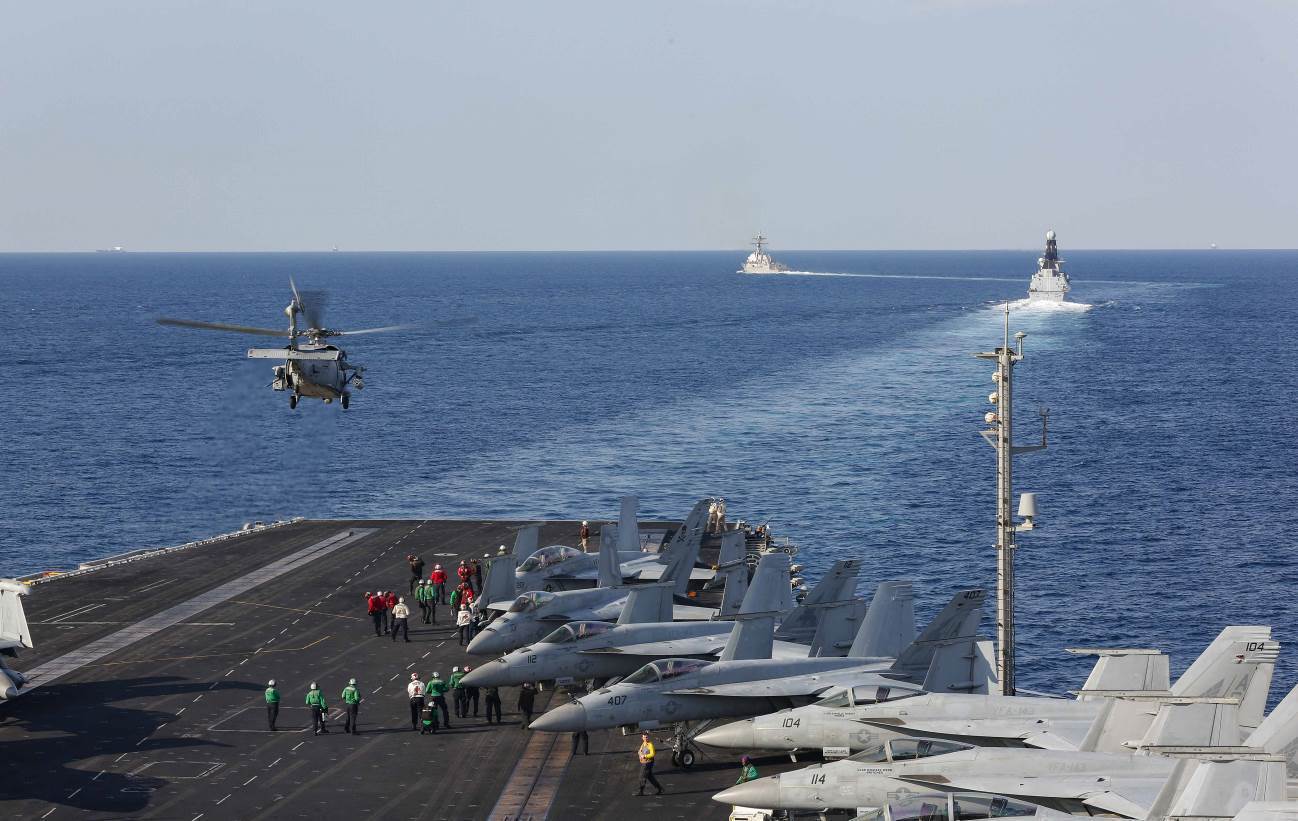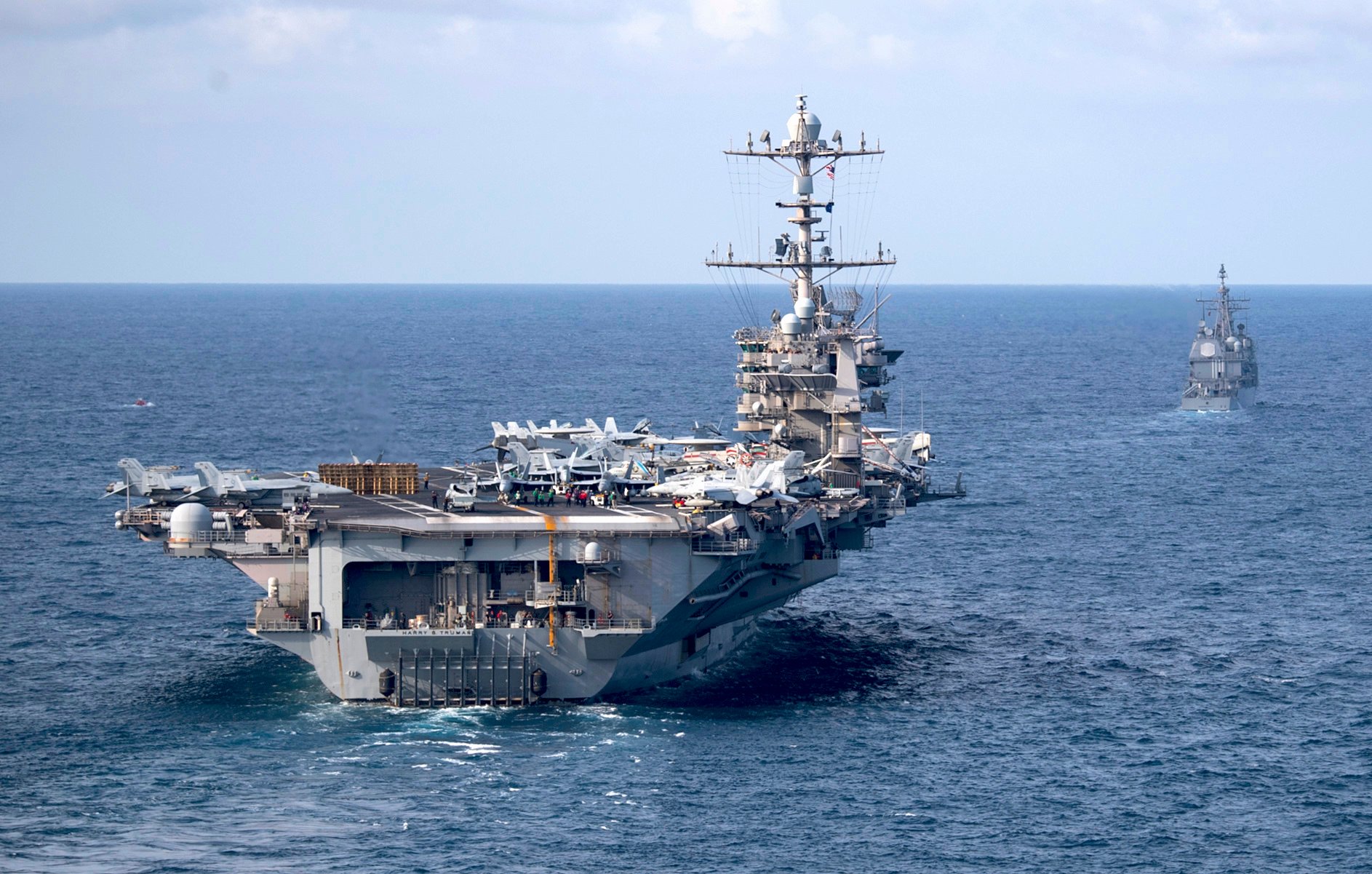
USS Abraham Lincoln (CVN-72) moved into the Persian Gulf for the first time since since it was scrambled to the Middle East in May, even as its replacement, USS Harry S. Truman (CVN-75) is back at sea with its air wing in final preparation to deploy after an electrical failure.
Lincoln and its strike group were on deployment earlier this year and hurried to the Middle East after then-National Security Advisor John Bolton called for an increased presence to counter Iranian aggression. The Lincoln Carrier Strike Group, though, spent all these months steaming in a tight operational box in the North Arabian Sea and the Gulf of Oman, with occasional port calls at Duqm, Oman.
The Lincoln CSG transited the Strait of Hormuz and is now operating in the Persian Gulf, Navy officials confirmed to USNI News on Tuesday.
The uneventful transit occurred in the early morning local time and was described by a Navy official as “safe and professional.” The sectarian Iranian Revolutionary Guard Corps Navy have been known to harass U.S. warships entering and exiting the Persian Gulf.
Defense officials stressed the move was not an escalation of tensions.
“The presence of the [Lincoln Strike Group] in the [Persian] Gulf does not represent escalation or a new policy toward Iran,” reads a statement from U.S. 5th Fleet.
In fact, the move of Lincoln to the Gulf could be an indication tensions with Iran have subsided to the point where U.S. officials felt it was safe enough for the carrier to transit the Strait. Lincoln will – once relieved by Truman – transit through the Pacific Ocean to its new homeport of San Diego, Calif., after having deployed from Norfolk, Va., in April. The move of the carrier into the Persian Gulf may give the crew access to the more established port and liberty facilities in Bahrain ahead of their long transit to California instead of only having access to the newer but more austere offerings in Oman, USNI News understands.
Meanwhile, Truman and its carrier air wing are at sea this week to reintegrate as a unit ahead of their deployment, a U.S. 2nd Fleet spokeswoman told USNI News. Lincoln is remaining on station in the Middle East until Truman can replace it.
“The Truman returned to sea yesterday in order to re-integrate the carrier and air wing after several months of maintenance, and is making final preparations to ensure the carrier, air wing, and Sailors are operationally ready for deployment,” Cmdr. Ashley Hockycko told USNI News today.
“The carrier strike group has maintained a high level of readiness since returning from deployment in December 2018 and have recently completed carrier qualifications aboard USS John C. Stennis (CVN-74).”

Hockycko added that the carrier qualifications conducted on Stennis in recent weeks were akin to the events carried out when an air wing is first joining up with an aircraft carrier ahead of the composite training unit exercise (COMPTUEX) that serves as a final training and certification event before deployment. Truman, its air wing and its surface combatant escorts had already completed COMPTUEX over the summer before Truman suffered an electrical failure in late August. While USNI News understands the air wing hasn’t been at risk of losing its certification throughout the delay, and the carrier qualifications aboard Stennis were meant to keep pilots’ skills sharp, this week’s reintegration activities will give one last change for the pilots, maintainers and ship’s crew to come back together and get back into a rhythm ahead of deploying likely by the end of the month.
The Virginian-Pilot first reported the carrier had returned to sea on Monday.
Hockycko noted that the air wing and Truman have a long history of working together – they first came together in February 2018 for integrated training and a COMPTUEX before their first deployment in this cycle of the Optimized Fleet Response Plan (OFRP). They then conducted a deployment primarily within U.S. 6th Fleet waters from April to December 2018, and they continued to operate together earlier this year in the OFRP sustainment phase ahead of this double-pump deployment.
Still, just as the carrier strike group was about to head out on this second deployment, Truman was sidelined with a failure within its electrical distribution system. Repairs spanned from September until last week, when the Navy declared the carrier was materially functional to deploy. During that time, the four escorts – cruiser USS Normandy (CG-60) and destroyers USS Forrest Sherman (DDG-98), USS Lassen (DDG-82) and USS Farragut (DDG-99) – departed to work as a surface action group in the North Atlantic. They have since transited to the Middle East, where they relieved the destroyer squadron there and are now serving to protect Lincoln.
“The strike group commander, ship commanding officer, and air wing commander are focused on ensuring the entire crew is ready to deploy. They are energized and in good spirits,” she said.
As for what ships may escort Truman into theater when the carrier leaves Norfolk, Va., to replace Lincoln in the Middle East, Hockycko said, “we will not get into specific schedule details, but the strike group commander has options regarding the make-up of the strike group.”





